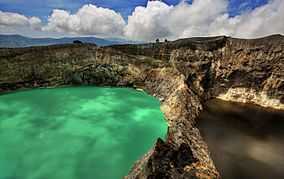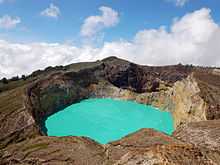Kelimutu
| Kelimutu | |
|---|---|
 | |
| Elevation | 1,639 m (5,377 ft)[1] |
| Listing |
List of volcanoes in Indonesia Spesial Ribu |
| Location | |
 Kelimutu | |
| Location | Ende Regency, Flores Island, Indonesia |
| Coordinates | 8°46′S 121°49′E / 8.77°S 121.82°ECoordinates: 8°46′S 121°49′E / 8.77°S 121.82°E |
| Geology | |
| Type | Complex volcano |
| Last eruption | 1968[1] |
Kelimutu ([kəliˈmutu]) is a volcano, close to the small town of Moni in central Flores island in Indonesia. The volcano is around 50km to the east of Ende, Indonesia, the capital of Ende regency in East Nusa Tenggara province.
Geological details
The volcano contains three striking summit crater lakes of varying colors. Tiwu Ata Mbupu (Lake of Old People) is usually blue and is the westernmost of the three lakes. The other two lakes, Tiwu Nuwa Muri Koo Fai (Lake of Young Men and Maidens) and Tiwu Ata Polo (Bewitched or Enchanted Lake) are separated by a shared crater wall and are typically green or red respectively. The lake colors vary on a periodic basis. Subaqueous fumaroles are the probable cause of active upwelling that occurs at the two eastern lakes.[1]
The lakes have been a source of minor phreatic eruptions in historical time. The summit of the compound 1639-m-high Kelimutu volcano is elongated two km in a WNW-ESE direction; the older cones of Kelido and Kelibara are located respectively three km to the north and two km to the south. The scenic lakes are a popular tourist destination.[2]
Kelimutu is also of interest to geologists because the three lakes have different colors yet are at the crest of the same volcano.[3] According to the local officer at Kelimutu National Park, the colour changes as a result of chemical reactions resulting from the minerals contained in the lake perhaps triggered by volcano gas activity.[4] Kawah Putih lake in West Java, south of Bandung, is another crater lake in Indonesia with some similarities to the lakes at Kelimutu.
Tourism
In the early days of developing the local national park in the Kelimutu area, there were some disputes with local communities over the use of the resources. More recently, forest rangers have worked to develop better relations with nearby village communities and overall management has improved.[5]
Kelimutu is one of the mountains listed as a ribu in Indonesia which are mountains in Indonesia which are more than 1,000 meters high.
The area is said to have begun to attract attention after being noticed by a regional Dutch military commander, B. van Suchtelen in 1915 and became more well-known after Y. Bouman wrote about the site in 1929.[6]
The closest airports are Maumere, and Ende. There are regular flights to Ende from Bali. The drive from Ende to Moni, the town at the base of Kelimutu where accommodation is available, takes about 3 hours.

Gallery
-

Tiwu Nuwa Muri Koo Fai (Lake of Young Men and Maidens) and Tiwu Ata Polo (Bewitched, or Enchanted Lake)
-

Tiwu Ata Mbupu (Lake of Old People)
-

The Keli Mutu lakes "Lake of Young Men and Maidens" and "Bewitched"
-

See also
References
- ↑ 1.0 1.1 1.2 "Kelimutu". Global Volcanism Program, Smithsonian Institution. http://www.volcano.si.edu/world/volcano.cfm?vnum=0604-14%3D.
- ↑ 'Kelimutu: Adventure to the Three coloured lakes', Accessed 29 April 2012.
- ↑ Pasternack, Gregory B.; Johan C. Varekamp (1994). "The geochemistry of the Keli Mutu crater lakes, Flores, Indonesia". Geochemical Journal 28 (3): 243–262. doi:10.2343/geochemj.28.243. Here's a link to the abstract
- ↑ Some details of the characteristics of volcanic soils in the area can be found at Hikmatullah, H. Subagyo, and B.H. Prasetyo, 'Soil properties of the eastern toposequence of Mount Kelimutu, Flores Island, East Nusa Tenggara and their potential for agricultural use', Indonesian Jour. of Agricultural Science, 4(1), 2003, pp. 1-11.
- ↑ Tifa Asrianti, 'Locals help protect Kelimutu national park', The Jakarta Post, 4 January 2011.
- ↑ Gagas Ulung (2011), Exotic NTT: 200 tempat paling menantang dan eksotis di provinsi Nusa Tenggara Timur: wisata alam, bahari, budaya, dan tradisi [Exotic NTT: 200 of the most challenging and exotic places in Nusa Tenggara Timur: tourism for nature, the sea, culture, and tradition], PT Gramedia Pustaka Utama, Jakarta, p. 184.
External links
| Wikimedia Commons has media related to Kelimutu. |
-
 Kelimutu travel guide from Wikivoyage
Kelimutu travel guide from Wikivoyage - Volume 28, No. 3, pp. 137-306 of the Geochemical Journal is a special issue of the journal dedicated to Volcanic lakes.
- Keli Mutu blog